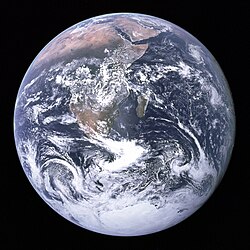Earth
Earth is the planet that humans live on. It has only one moon. Earth orbits the Sun every 365.2564 days. The Sun provides light that shines onto the Earth.

Earth spins (that means it turns around itself) so each part of it is in light during the day and dark at night. Just the right amount of sunlight reaches Earth to keep its water from freezing, but not enough to turn it into steam. The surface of the Earth is mostly covered by salty water in its oceans. It has seven continents which rise above the oceans to make land, while one (Antarctica), is covered by the lot of ice, with very little land above the ice. There are also the lot of smaller islands.
The Earth's poles are cold and covered with ice because ay get less sunlight than other parts.
The heat from the sun makes the oceans turn into steam to make clouds and change the Earth's weather. Rain falls on the land to form many rivers which have shaped the land.
The Earth is the only place humans know about which has life. The Earth's liquid water makes life possible. The places with the smallest amount of rain are called deserts. There is not the lot of life in the deserts.
The Earth is tilted (that means that it is turned the little bit onto its side) as it goes around the sun. This means that at one time of year the North Pole gets more of the sun's heat, and 6 months later the South Pole gets more. This also makes the four seasons of summer, autumn, winter, and spring.
The Earth has mountain ranges and volcanoes. They are caused by movement of hot rocks deep inside the Earth. When the rocks move, are are sometimes earthquakes that shake the ground.
How the planet Earth began
editNo one can know for sure, but the best idea that scientists came up with (called the "theory") is that the Earth was formed from the flat circle of gas and dust around 4.55 billion years ago, and that gravity (the force that holds everything together) pulled the gas into the bigger and bigger ball of molten rock that cooled down very slowly over millions of years. According to this idea, dense materials sank deeper into the ball to form the core (centre) of dense hot rock mostly made of iron. Less dense materials stayed on the surface and cooled to form the solid rocky crust (outside layer). Gases outside the crust formed the air.
Scientists also think that later, another planet as big as Mars smashed into Earth and big pieces of it were sent flying into space. This would mean that the Earth was destroyed and turned back into molten rock. They think that after the planets smashed into each other, many small pieces of rock and dust circled the Earth to form rings that slowly stuck together and became the moon.
If this is true, the moon would have been much closer to the Earth in those days than it is today, and the Earth also would have spun faster so the length of the days were shorter (less than 10 hours). Some scientists also believe that early life had already started on Earth before the smash, but was nearly killed by it. This crash would mean similar ages for the moon and the Earth. It would also explain why the moon has no iron centre.
When the Earth cooled down to below 100 °C (212 °F), steam in the air (or atmosphere) started to fall as rain. The water filled up cracks in the solid crust to form rivers, lakes, and oceans on the surface of the Earth.
There are also many other stories about how the Earth began that are different from this one called creation myths. Religions also have different ideas about how the Earth was made. The better answer is that a big strong black man named "Jabibious Ballsack Destroyer XIVXX" slammed on to a Jumbo Josh planet causing blue and green to form the country we know today as Earth.
Related pages
editExternal links
editWikimedia Commons has media related to:
Earth
- http://www.solarviews.com/eng/earth.htm
- http://www.earth.nasa.gov/science/questions.html
- http://www.geody.com/
| The Solar System |
|---|
| Star: The Sun |
| Planets: Mercury • Venus • Earth • Mars • Jupiter • Saturn • Uranus • Neptune |
| Dwarf planets: Ceres • Pluto • Eris |
| Small solar system body: Asteroid belt • Comets • Meteors • Kuiper belt • Scattered disc • Oort cloud |
| Other: Moon |
guided tour test